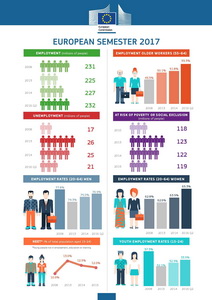 The Commission has set out its views on the EU’s economic and social priorities for the year ahead, building on the guidance from President Juncker’s 2016 State of the Union address and on the latest economic data from the Commission’s Autumn 2016 Forecast.
The Commission has set out its views on the EU’s economic and social priorities for the year ahead, building on the guidance from President Juncker’s 2016 State of the Union address and on the latest economic data from the Commission’s Autumn 2016 Forecast.
This package starts the 2017 cycle of economic governance, the so-called European Semester.
The 2017 Draft Joint Employment Report confirms that the economic recovery has been accompanied by job creation and lower unemployment, also thanks to recent structural reforms in a number of Member States. Here are some highlights:
- 8 million new jobs have been created since 2013 when the recovery started. Of these more than four million jobs were created throughout 2015 and the first half of 2016. The employment rate in the age group 20-64 reached 71.1% in the second quarter of 2016 and for the first time above that observed in 2008. This means that the 75% employment rate target set by the Europe 2020 strategy for 2020 could be within reach, if the current trend continues.
- The EU unemployment rate kept falling and stood at 8.5% in September 2016 (10% in the euro area), reaching its lowest level since 2009 (since 2011 in the euro area). Latest data suggest that there are now 5.7 million fewer people unemployed than in April 2013, when unemployment reached its peak. Nevertheless, there are over 20 million Europeans that remain unemployed, including almost 10 million long term unemployed. Of those unemployed 4 million are young people 15-24.
- The number and proportion of people at-risk-of poverty or social exclusion has started to decrease but is still high. Around 119 million people are still at risk of poverty or social exclusion. Children, not less than 25 million of them, are some of those more strongly affected.
- Women continue to be underrepresented in the labour market and face an important pay differential.
- Despite first signals of convergence among Member States, employment and social outcomes continue to vary significantly across countries. For example, the employment rate ranges from just 56% in Greece to 81% in Sweden.
- Income inequality has stopped growing in most countries in 2015 but remains high and high inequality levels reduce economic output and the potential for sustainable growth.
Source: ec.europa.eu
 Government of the Republic of Serbia
Government of the Republic of Serbia















 pdf [271 KB]
pdf [271 KB]
Leave a Comment